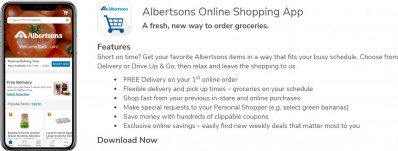To overcome challenges selling groceries online, firms need to make eCommerce a C-suite priority

“Ecommerce is a primary tool that if brands are not already using they should do so immediately, because this is where the future is,” Guilherme Lebelson, global VP of eCommerce at ZX Ventures, told FoodNavigator-USA late last month at the Digital Food & Beverage conference in Austin, Texas.
He explained that while ecommerce may not yet pull its weight in terms of sales for groceries, it offers many other benefits.
“First and foremost, ecommerce allows brands to have a direct connection to their final consumer. This is a place where you can learn so much faster, get feedback so much faster, and, of course, design your brand based on that feedback,” he said.
In addition, he noted, “ecommerce is a great place for storytelling, for customization, for driving much better content than you would perhaps in a more traditional retail setting.”
And finally, he said, “this is where your consumer is,” and failing to meet them there is a missed opportunity that could have long-term negative implications for brands.
“As consumers start immigrating online, if our products are not there then we risk losing those consumers,” he added.
Developing an ecommerce strategy needs to come from the top
Given how ecommerce cuts across many business segments, including marketing, customer service, product development and, yes, even sales, Lebelson says developing an online strategy needs to be a strategic priority addressed at the C-suite level.
“This cannot be something that is sitting inside one area or another. This needs to be a CEO priority, and for that it may require companies to adopt different organizational designs,” so that the responsibility for it and benefits from it are fully shared across the board, he said.
He recognized that reorganizing a company – especially a large established one – can be uncomfortable, but he said, “it is better to disrupt yourself as a company to avoid being disrupted [in the market]. So, therefore, making some tough choices inside your organization.”
Finding solutions for challenges
By having leaders from across the company work together, they will be better positioned to find solutions more quickly to the challenges that currently are holding back online sales of groceries – which Lebelson noted are very real.
“The No. 1 challenge [for selling groceries online] is the nature of the product being heavy, being lower margin – that makes it not the most ecommerce-friendly given the current set up for ecommerce is a large warehouse or food center” where products are stores and shipped from, he said.
He explained that currently many companies are addressing these challenges by paying more for faster shipping and using additional insulation or chill packs to protect fragile or perishable food – all of which adds to the products’ cost.
To an extent, companies can pass this added cost on to consumers, who are willing to pay for it because they value the convenience of the delivery, Lebelson said. However, he added, as more brands move online consumers’ willingness to pay higher prices will diminish – leaving brands to either pick up he extra cost or find another alternative.
One of those other options is to open additional fulfillment centers that will reduce the travel time to different destinations around the country, Lebelson said.
The founder of the frozen plant-based meal company Veestro recently did this and has seen tremendous cost-savings as well as positive feedback from consumers who are happy to receive their products more quickly than when the company had only one fulfillment center on the West Coast.
Lebelson adds that other solutions likely will emerge quickly as larger players enter the space and are able to put their weight behind the problems.
“An example is the way Amazon is leveraging Whole Foods as a footprint to be closer to the consumer or the way that Walmart is exploring their click-and-collect features, both of which were not available a few years ago and to an extent which are still being proven out today. But I think that everyone will follow once they find the right answers,” he said.
He also noted that last-mile delivery services are maturing in a way that could offer solutions to the grocery industry’s online sales challenges.
Ultimately, he said, the solutions will come and when they do the companies that are already in the space will be best positioned to take advantage of them and grow, while others who are slower to move online are still struggling with the basics.










